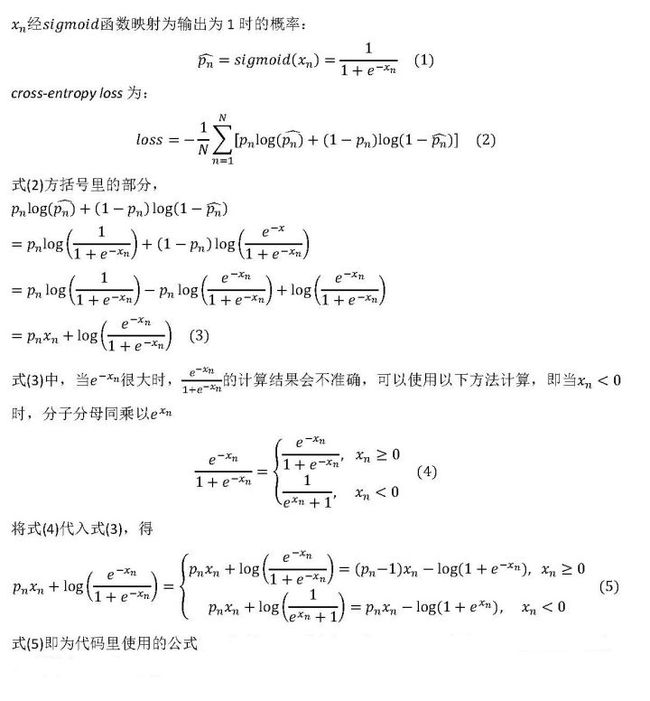本文首发于微信公众号《与有三学AI》
[caffe解读] caffe从数学公式到代码实现4-认识caffe自带的7大loss
本节说caffe中常见loss的推导,具体包含下面的cpp。
multinomial_logistic_loss_layer.cppsoftmax_loss_layer.cppeuclidean_loss_layer.cppsigmoid_cross_entropy_loss_layer.cppcontrastive_loss_layer.cpphinge_loss_layer.cppinfogain_loss_layer.cpp
1 multinomial_logistic_loss_layer.cpp
数学定义
x是输入,y是label,l是loss
上述式只有当样本i属于第k类时,
yk=1,其他情况 ,yk=0,我们计不为0的 yk =y。
forward & backward
forward对所有 Xi求和,注意,此处没有对图像维度的像素进行归一化,只对batch size维度进行归一化,num就是batch size,这与下面的softmaxlosslayer是不一样的。
void MultinomialLogisticLossLayer::Forward_cpu(
const vector*>& bottom, const vector*>& top) {
const Dtype* bottom_data = bottom[0]->cpu_data();
const Dtype* bottom_label = bottom[1]->cpu_data();
int num = bottom[0]->num();
int dim = bottom[0]->count() / bottom[0]->num();
Dtype loss = 0;
for (int i = 0; i < num; ++i) {
int label = static_cast(bottom_label[i]);
Dtype prob = std::max( bottom_data[i * dim + label], Dtype(kLOG_THRESHOLD));
loss -= log(prob);
}
top[0]->mutable_cpu_data()[0] = loss / num;
}
backward可以自己去看,很简单就不说了
2 softmax_layer.cpp
数学定义
softmax是我们最熟悉的了,分类任务中使用它,分割任务中依然使用它。Softmax loss实际上是由softmax和cross-entropy loss组合而成,两者放一起数值计算更加稳定。
令z是softmax_with_loss层的输入,f(z)是softmax的输出,则
单个像素i的softmax loss等于cross-entropy error如下
展开上式:
在网络中,z是即bottom blob,l(y,z)是top blob,反向传播时,就是要根据top blob diff得到bottom blob diff,所以要得到
下面求loss对z的第k个节点的梯度
可见,传给groundtruth label节点和非groundtruth label是的梯度是不一样的。
forward就不看了,看看backward吧。
Dtype* bottom_diff = bottom[0]->mutable_cpu_diff();
const Dtype* prob_data = prob_.cpu_data();
caffe_copy(prob_.count(), prob_data, bottom_diff);
const Dtype* label = bottom[1]->cpu_data();
int dim = prob_.count() / outer_num_;
int count = 0;
for (int i = 0; i < outer_num_; ++i) {
for (int j = 0; j < inner_num_; ++j) {
const int label_value = static_cast(label[i * inner_num_ +
j]);
if (has_ignore_label_ && label_value == ignore_label_) {
for (int c = 0; c < bottom[0]->shape(softmax_axis_); ++c) {
bottom_diff[i * dim + c * inner_num_ + j] = 0;
}
} else {
bottom_diff[i * dim + label_value * inner_num_ + j] -= 1;
++count;
}
}
}
Test_softmax_with_loss_layer.cpp
作为loss层,很有必要测试一下,测试也分两块,forward和backward。
Forward测试是这样的,定义了个bottom blob data和bottom blob label,给data塞入高斯分布数据,给label塞入0~4。
blob_bottom_data_(new
Blob
blob_bottom_label_(new
Blob
然后分别ingore其中的一个label做5次,最后比较,代码如下。
Dtype accum_loss = 0;
for (int label = 0; label < 5; ++label) {
layer_param.mutable_loss_param()->set_ignore_label(label);
layer.reset(new SoftmaxWithLossLayer
layer->SetUp(this->blob_bottom_vec_,
this->blob_top_vec_);
layer->Forward(this->blob_bottom_vec_, this->blob_top_vec_);
accum_loss += this->blob_top_loss_->cpu_data()[0];
}
// Check that each label was included all but
once.
EXPECT_NEAR(4 * full_loss, accum_loss, 1e-4);
至于backwards,直接套用checker.CheckGradientExhaustive就行,它自己会利用数值微分的方法和你写的backwards来比较精度。
TYPED_TEST(SoftmaxWithLossLayerTest,
TestGradientIgnoreLabel) {
typedef typename TypeParam::Dtype Dtype;
LayerParameter layer_param;
//
labels are in {0, ..., 4}, so we'll ignore about a fifth of them
layer_param.mutable_loss_param()->set_ignore_label(0);
SoftmaxWithLossLayer
GradientChecker
checker.CheckGradientExhaustive(&layer, this->blob_bottom_vec_,
this->blob_top_vec_, 0);
}
3 eulidean_loss_layer.cpp
euclidean loss就是定位检测任务中常用的loss。
数学定义:
forward & backward
void EuclideanLossLayer
vector
const vector
vector
for (int i = 0; i < 2; ++i) {
if (propagate_down[i]) {
const Dtype sign = (i == 0) ? 1 : -1;
const Dtype alpha = sign * top[0]->cpu_diff()[0] / bottom[i]->num();
caffe_cpu_axpby( bottom[i]->count(), // count
alpha, // alpha
diff_.cpu_data(), // a
Dtype(0), // beta
bottom[i]->mutable_cpu_diff()); // b
}
}
}
testcpp就不说了。
4 sigmoid_cross_entropy_loss_layer.cpp
与softmax loss的应用场景不同,这个loss不是用来分类的,而是用于预测概率,所以在loss中,没有类别的累加项。
令第i个节点输入 Xi,输出总loss为l,label为 yi,则loss定义如下
其中
上式子有个等价转换,这是为了更好的理解caffe 中forward的计算,公司太多我就直接借用了,如果遇到了原作者请通知我添加转载申明。
http://blog.csdn.net/u012235274/article/details/51361290
反向求导公式如下:
在经过上面的转换后,避开了数值计算不稳定的情况,caffe中的源码是对整个的bottom[0]->count进行计算累加的,没有区分label项。
for (int i = 0; i < bottom[0]->count(); ++i) {
const int target_value = static_cast
if (has_ignore_label_ && target_value == ignore_label_) {
continue;
}
loss -= input_data[i] * (target[i] - (input_data[i] >= 0)) - log(1 + exp(input_data[i] - 2 * input_data[i] * (input_data[i] >= 0)));
++valid_count;
}
反向传播很简单就不看了
5 contrastive_loss_layer.cpp
有一类网络叫siamese network,它的输入是成对的。比如输入两张大小相同的图,网络输出计算其是否匹配。所采用的损失函数就是contrastive loss
数学定义:
d就是欧氏距离,y是标签,如果两个样本匹配,则为1,否则为0. 当y=1,loss就是欧氏距离,说明匹配的样本距离越大,loss越大。当y=0,是,就是与阈值margin的欧式距离,说明不匹配的样本,欧氏距离应该越大越好,超过阈值最好,loss就等于0.
反向传播其实就是分y=1和y=0两种情况下的euclidean loss的反向传导,由于与euclidean
loss非常相似,不再赘述。
6 hinge_loss_layer.cpp
这是一个多分类的loss, 也是SVM的目标函数,没有学习参数的全连接层InnerProductLayer+HingeLossLayer就等价于SVM。
数学定义
这个层的输入bottom[0]是一个N*C*H*W的blob,其中取值任意值,label就是N*1*1*1,其中存储的就是整型的label{0,1,2,…,k}。
相当于SVM中的
参考博客http://blog.leanote.com/post/braveapple/Hinge-Loss-%E7%9A%84%E7%90%86%E8%A7%A3
假如预测类别数是K个,正确的label是M,预测值为
,即是第n个样本对第k类的预测值,那么当k=M时,
当k!=M时,
其中p=1,p=2分别对应L1范数和L2范数,以L1为例
Forward
caffe_copy(count, bottom_data, bottom_diff);
for (int i = 0; i < num; ++i) { bottom_diff[i * dim + static_cast
}
for (int i = 0; i < num; ++i) {
for (int j = 0; j < dim; ++j) {
bottom_diff[i * dim + j] = std::max( Dtype(0), 1 + bottom_diff[i * dim + j]);
}
}
Dtype* loss = top[0]->mutable_cpu_data();
switch (this->layer_param_.hinge_loss_param().norm()) {
case HingeLossParameter_Norm_L1:
loss[0] = caffe_cpu_asum(count, bottom_diff) / num; break;
case HingeLossParameter_Norm_L2:
loss[0] = caffe_cpu_dot(count, bottom_diff, bottom_diff) / num; break;
default: LOG(FATAL) << "Unknown Norm";
}
只需要根据上面的转化后的式子,在正确label处乘以-1,然后累加即可。
再看反向梯度求导:
当进行一次forward之后,
bottom_diff=
[max(0,1+t0),max(0,1+t1),...,max(0,1−tk),...,
max(0,1−tK-1)]
我们现在要求梯度,期望是1+tk>0时为1,1-tk>0时为-1,其他情况为0,
当任意一项1+tk或者1-tk<0时,会有梯度=0。实际上就是求上面向量各自元素的符号,当1+tk>0,sign(1+tk),只是max(0,1−tk)这个应该反过来,当1-tk>0时,sign(tk-1)=-1。
代码如下:
Dtype* bottom_diff = bottom[0]->mutable_cpu_diff();
const Dtype* label = bottom[1]->cpu_data();
int num = bottom[0]->num();
int count = bottom[0]->count();
int dim = count / num;
for (int i = 0; i < num; ++i) {
bottom_diff[i * dim + static_cast(label[i])] *= -1;
}
const Dtype loss_weight = top[0]->cpu_diff()[0];
switch (this->layer_param_.hinge_loss_param().norm()) {
case HingeLossParameter_Norm_L1:
caffe_cpu_sign(count, bottom_diff, bottom_diff);
caffe_scal(count, loss_weight / num, bottom_diff);
break;
case HingeLossParameter_Norm_L2:
caffe_scal(count, loss_weight * 2 / num, bottom_diff);
break;
default: LOG(FATAL) << "Unknown Norm";
}
}
7 infogain_loss_layer.cpp
数学定义:
输入bottom_data是N*C*H*W维向量,bottom_label是N*1*1*1维向量,存储的就是类别数。它还有个可选的bottom[2],是一个infogain matrix矩阵,它的维度等于num_of_label * num_of_label。每个通道c预测的是第c类的概率,取值0~1,所有c个通道的概率相加=1。是不是像soft Max?
实际上它内部就定义了shared_ptr > softmax_layer_,用于映射输入。
Loss定义如下:
代表H的第ln行,K是所有类别数,如果H是一个单位矩阵,那么只有对角线有值,回到文章开头,这就是multinomial_logistic_loss_layer。当H是一个普通矩阵时,当groundtruth label为k,
时,值也可以非零。这样各个类别之间就不存在竞争关系了,后来的mask-rcnn中实际上loss也就是去除了这重竞争关系。
Forward:
void InfogainLossLayer
const vector
softmax_layer_->Forward(softmax_bottom_vec_, softmax_top_vec_);
const Dtype* prob_data = prob_.cpu_data();
const Dtype* bottom_label = bottom[1]->cpu_data();
const Dtype* infogain_mat = NULL;
if (bottom.size() < 3) { infogain_mat = infogain_.cpu_data();
} else { infogain_mat = bottom[2]->cpu_data();}
int count = 0;
Dtype loss = 0;
for (int i = 0; i < outer_num_; ++i) {
for (int j = 0; j < inner_num_; j++) {
const int label_value = static_cast(bottom_label[i * inner_num_ + j]);
if (has_ignore_label_ && label_value == ignore_label_) {continue;}
DCHECK_GE(label_value, 0);
DCHECK_LT(label_value, num_labels_);
for (int l = 0; l < num_labels_; l++)
{ loss -= infogain_mat[label_value * num_labels_ + l] * log(std::max( prob_data[i * inner_num_*num_labels_ + l * inner_num_ + j],
Dtype(kLOG_THRESHOLD)));}
++count; } }
top[0]->mutable_cpu_data()[0] = loss / get_normalizer(normalization_, count);
if (top.size() == 2) { top[1]->ShareData(prob_); }}
上面与multinomial_logistic_loss_layer的区别就在于每一项乘了infogain_mat[label_value *
num_labels_ + l]。
Backward:
for (int l = 0; l < num_labels_; ++l) {
bottom_diff[i * dim + l * inner_num_ + j] = prob_data[i*dim + l*inner_num_ + j]*sum_rows_H[label_value] - infogain_mat[label_value * num_labels_ + l];
}
这个,看了4篇了大家不妨自己推一推?不行咱再一起来
更多请移步
1,我的gitchat达人课
龙鹏的达人课
2,AI技术公众号,《与有三学AI》
一文说说这十多年来计算机玩摄影的历史
3,以及摄影号,《有三工作室》
冯小刚说,“他懂我”












